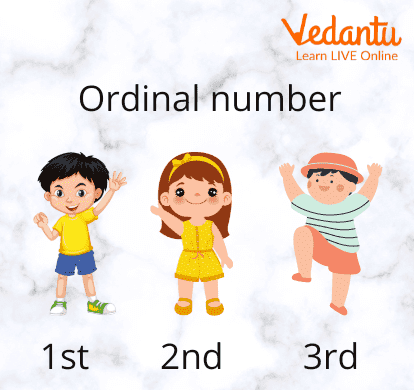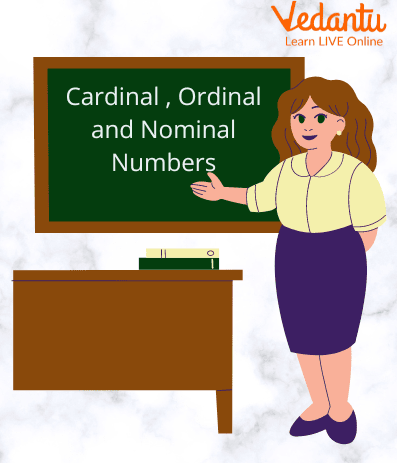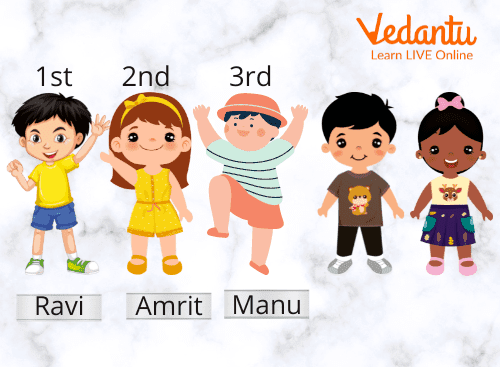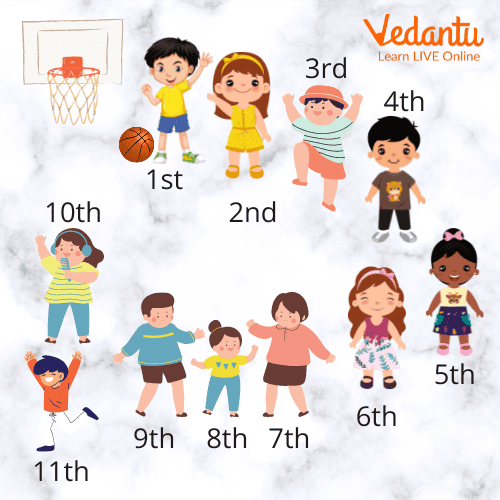




Introduction to Ordinal Numbers for Kids
The numbers that describe the positions of objects are known as ordinal numbers. Children learn to count from one to ten very quickly, and maybe they know the numbers from twenty-one to thirty also. But what are ordinal numbers? Ordinal numbers allow us to answer questions like "what is the 5th number in the set of numbers one through ten?" or "which number is greater: 7 or 14?"

Ordinal Numbers 1 to 20
If the number of things or people is given as a list, ordinal numbers are used to determine the order of the items or people. First - First, Second - Second, Third - Third, Fourth - Fourth, Fifth - Fifth, Sixth - Sixth, and so on are the adjective phrases that are used to express the order of something or someone. These phrases all refer to ordinal numbers examples. While the counting numbers, such as 0, 1, 2, 3, 4, and 5, are known as cardinal numbers. So as of now, we have seen the ordinal position definition and some examples based on the ordinal position definition. Now let’s see it in detail.
What are Ordinal Numbers?

Ordinal Numbers
An ordinal number, such as first, second, third, and so on, represents the place or order of something about other numbers. The size, importance, or any other chronology may determine the order or sequence.
Let's use an example to better understand ordinal numbers. Ten students took part in the competition. Out of these, the first, second, and third place winners each received a medal and were recognized. First, second, and third are ordinal numbers in this instance.
Difference Between Cardinal, Nominal, and Ordinal Numbers

Difference Between Cardinal, Nominal, and Ordinal Numbers
In addition to ordinal numbers, there are two other sorts of numbers that can be used to represent things or persons.
Cardinal Numbers
Nominal Numbers
Cardinal Numbers: Counting numbers that are used to indicate the number of individuals or items are known as Cardinal Numbers. They are as follows: 1, 2, 3, 4, 5, 6, 7, 8, 9, 10, and so on.
Nominal Numbers: The names given to the items in a group are given a numerical designation as nominal numbers. Example- Pin codes of different cities
Ordinal Numbers: The figures that represent an object or a person's position.
Example - Due to severe air pollution, the city placed second.
Ordinal Numbers Examples

Ordinal Numbers Examples
Here is the list of ordinal numbers examples used in sentences -
My birthday is on February 15th.
The third story of the structure is where the library is situated.
He attends sixth grade.
I finished second in the competition.
The following week marks my grandmother's 80th birthday.
January is the first month of the year.
When the new iPhone went on sale, my brother was among the first customers in line.
Begin by folding the piece of paper in half. The paper should now be folded twice.
Ordinal Numbers List

Ordinal Numbers List
Ordinal Numbers 1 to 20
1st: First
2nd: Second
3rd: Third
4th: Fourth
5th: Fifth
6th: Sixth
7th: Seventh
8th: Eighth
9th: Ninth
10th: Tenth
11th: Eleventh
12th: Twelfth
13th: Thirteenth
14th: Fourteenth
15th: Fifteenth
16th: Sixteenth
17th: Seventeenth
18th: Eighteenth
19th: Nineteenth
20th: Twentieth
Solved Examples
Q1. Fill in the blanks with correct ordinal numbers.
S is the ____ letter in the word NEST.
C is the____ letter in the word CLASS.
Ans:
S is the third letter in the word NEST.
C is the first letter in the word CLASS.
Q2. Sam, John, Mary, and Louis are the students of a class, standing in a row, in the given order. Who is in the second position?
Ans: If Sam, John, Mary, and Louis are standing in the given order, then John is in the second position.
Practice Problems
Q1. Write ordinal numbers from 1 to 20.
Ans: First, Second, Third, Fourth, Fifth, Sixth, Seventh, Eighth, Ninth, Tenth, Eleventh, Twelfth, Thirteenth, Fourteenth, Fifteenth, Sixteenth, Seventeenth, Eighteenth, Nineteenth, and Twentieth
Q2. In the word “BEAUTIFUL”, find the first and last letters.
Ans: The first letter is B and the last letter is L.
Summary
Ordinal numbers are used to denote the location or order of items or objects. These numbers display the order. Due to the positioning and status of objects, their purpose is to arrange various things in a logical order. Since the counting process requires the labeling of items with numbers, ordinal numbers provide precise location information when objects are arranged in order. Ordinal numbers are frequently used in science, literature, mathematics, and other fields.
FAQs on Ordinal Numbers 1 to 20: Fun Learning
1. What are ordinal numbers in math or ordinal numbers for kids?
Ordinal numbers for kids are defined as first, second, third, fourth, etc., which represents a list of item's positions.
Dates are the example of an ordinal number because they provide the timing of an event. Items are identified with ordinal numbers (for example the pages in a book).
2. What is the use of ordinal numbers?
We use ordinal numbers to order and position things and numbers. For example, we might use them to state where someone finished in a race, recite numbers, or arrange numbers on a time or number line.
3. What is the definition of the ordinal position?
Ordinal position refers to the actual order in which the child was born; i.e., first, second, third…tenth, eleventh, and so on.
4. Write some everyday use of ordinal numbers in our life?
Use ordinal numerals to indicate the sequence of dates or the sequence of events. Ordinal numbers should only be used when sorting over data that has been provided. Saying that the individual who attempted the paper performed an excellent and skillful job of winning the top spot is an example of how we may express it. The student who performed the worst was put last in the class, while the one who performed better but not as well as the first was placed second. To achieve this, ordinal numerals are used.
5. How should a number be written in ordinal form?
Ordinal numbers, such "first," "second," and "third," indicate the hierarchy or significance of items in a list or series.
Ordinals that are expressed as numerals always contain a suffix: "-st" for "first," "-nd" for "second," and so on.
"-rd" stands for "third," "103rd," "-th" for "fourth," “54" and so forth.











